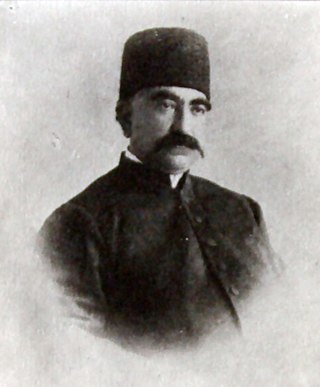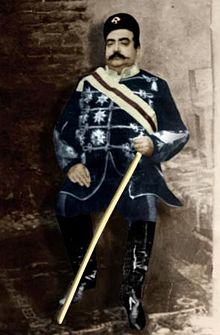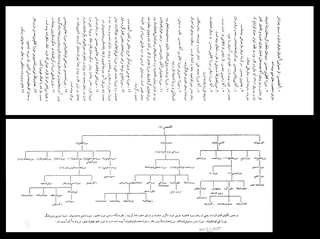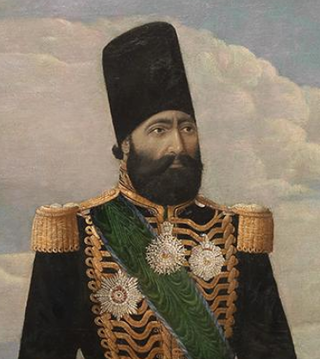
Sattar Khan, honorarily titled Sardār-e Melli was a pivotal figure in the Iranian Constitutional Revolution and is considered a national hero by the Iranian people.

Ahmad Hokmabadi Tabrizi, later known as Ahmad Kasravi, was a pre-eminent Iranian historian, jurist, linguist, theologian, a staunch secularist and intellectual. He was a professor of law at the University of Tehran, as well as an attorney and judge in Tehran, Iran.

Mirzā Jahāngir Khān, also known as Mirzā Jahāngir Khān Shirāzi and Jahāngir-Khān-e Sūr-e-Esrāfil, was an Iranian writer and intellectual, and a revolutionary during the Iranian Constitutional Revolution (1905–1911). He is best known for his editorship of the progressive weekly newspaper Sur-e Esrāfil, of which he was also the founder. He was executed, at the age of 38, or 32, for his revolutionary zeal, following the successful coup d'état of Mohammad-Ali Shah Qajar in June 1908. His execution took place in Bāgh-e Shāh in Tehran, and was attended by Mohammad-Ali Shah himself. He shared this fate simultaneously with his fellow revolutionary Mirzā Nasro'llah Beheshti, better known as Malek al-Motakallemin. It has been reported that immediately before his execution he had said "Long live the constitutional government" and pointed to the ground and uttered the words "O Land, we are [being] killed for the sake of your preservation [/protection]".

The Persian Constitutional Revolution, also known as the Constitutional Revolution of Iran, took place between 1905 and 1911. The revolution led to the establishment of a parliament in Persia (Iran) during the Qajar dynasty.

Kamran Mirza, was a Persian Prince of Qajar dynasty and third surviving son of Nasser al-Din Shah. He was the brother of Mass'oud Mirza Zell-e Soltan and Mozzafar al-Din Shah. He was also the progenitor of the Kamrani Family. He might have been Prime minister of Iran for a few days in April–May 1909, but this is not clearly referenced. Kamran Mirza also served as Iran's Commander-in-Chief, appointed in 1868 for the first time, and minister of war from 1880 to 1896 and from 1906 to 1907.

Ali Akbar Bahman was an Iranian diplomat and politician during the Qajar and Pahlavi eras.
Sam Khan, the headman of Haji-Alilu tribe of Arasbaran, was a legendary military commander in early twentieth century. He was given honorary titles such as Arshad Nezam, Sardar Arshad, Shoja Nezam, Salar Nezam, and Amir Arshad. In Chronicles of Naser al-Din Shah Qajar era, Amir Arshad is referred to as the commander of mounted troops stationed in Qaradağ. Amir Arshad and his brother, Moḥammad Ḥosayn Khan Sardār(-e) Ashayer, supported the Constitutionalists during Persian Constitutional Revolution. In the winter of 1909-10, they helped revolutionary forces crush the Chalabianlu and their allies, who, under the leadership of Rahimkhan Chalabianloo, had been the major supporters of the deposed Mohammad Ali Shah Qajar. Consequently, in 1911-1920 period, Amir Arshad was effectively ruling Arasbaran region, a vast area north of Tabriz.

Sardar Rafie Yanehsari (1856-1930) was the Wali of velayat of Astarabad and Governor of Gorgan from the time of Naser el-Din Shah to Reza Shah and was a member of Yanehsari Dynasty. Sardar Rafi played a major role in the development of the areas under his rule, the first explorations in Gorgan, the first carvings in Tepe Hisar, the construction of the road between Gorgan and Tehran and the introduction of modern science to Gorgan, Only part of his activity was during his 39 years of rule. Sardar Rafi first came to power in February 1892, when he was succeeded by his father, Lotf Ali Khan Sartip, who ruled the Hezarjarib region and rose to the rank of brigadier general. In addition to his services to modernize the areas under his rule, he and his nephew, Amir Khan-e Sardar, played an important role in suppressing Turkmen insurgency.

The Bahmani family, also Bahmani-Qajar is an aristocratic Iranian family belonging to one of the princely families of the Qajar dynasty, the ruling house that reigned Iran 1785–1925. The founder is Bahman Mirza Qajar (1810–1884), the younger brother of Mohammad Shah Qajar and formerly prince regent and governor of Azerbaijan 1841–1848.
The Iranian women participated actively in constitutional, struggles. From the year 1906 women's organizations were formed and many women participated in constitutionalism. But the National Women's Movement was just a minority movement and part of the great national movement of Iran with the goal of the independence of the country and the implementation of the constitution. The participation of women in these political events was spontaneous, with their new nationalist sentiment and willingness to be recognized.

Anoushirvan (Shir) Khan Qajar Qovanlou 'Eyn ol-Molk' 'Etezad od-Doleh' was an Iranian aristocrat, general and courtier.

The Iranian Enlightenment, sometimes called the first generation of intellectual movements in Iran, brought new ideas into traditional Iranian society from the mid-nineteenth to the early twentieth century. During the rule of the Qajar dynasty, and especially after the defeat of Iran in its war with the Russian Empire, cultural exchanges led to the formation of new ideas among the educated class of Iran. This military defeat also encouraged the Qajar commanders to overcome Iran's backwardness. The establishment of Dar ul-Fonun, the first modern university in Iran and the arrival of foreign professors, caused the thoughts of European thinkers to enter Iran, followed by the first signs of enlightenment and intellectual movements in Iran.

Mostowfian Ashtiani family were a Persian family during the Zand period who came to power in the Qajar dynasty and retained power until the middle of the Pahlavi dynasty. Their family occupation was land ownership, but after in Qajar introduced the position of Mostowfi into the Iranian bureaucracy, the family began to work as Mustawfis and took their name from this title. Mostowfian Ashtiani became known as the "Hezar Famil" because of their influence and power in the Qajar bureaucracy.

Mirza Yusuf Ashtiani also known as Mostowfi ol-Mamalek was the Grand Vizier of Iran during the reign of Nasser al-Din Shah and one of the most influential members of Qajar bureaucratic system at that time. He was from the conservative faction of the Qajar court and an opponent of Mirza Hosein Khan Moshir od-Dowleh and his reforms.

Mirza Mohammad Khan Davallu Qajar also known as Kashikchi Bashi and then Sepahsalar was the Grand Vizier of Persia during the reign of Naser al-Din Shah Qajar.

The Imperial Russian involvement in the Persian Constitutional Revolution was to support the authoritarian faction led by Mohammad Ali Shah to defeat the constitutionalists. Until 20 April 1909, when the Russian army under Major General I. Snarsky occupied Tabriz to protect the Russian consuls, the Russian Empire indirectly supported Ali Shah and the authoritarian faction. Support from the Russian Empire included sending weapons, lending money to Colonel Vladimir Liakhov, the commander of the Persian Cossack Brigade, and a large-scale propaganda machine against the constitutionalist leaders.

Mujahideen of Saturday is a term used by Ahmad Kasravi and Mehdi Malekzadeh in their books of History of the Iranian Constitutional Revolution. Originally, this term mention those politicians who weren't Constitutionalists in Persian Constitutional Revolution but when Mohammad Ali Shah deposed, Suddenly they changed their faction. two examples that kasravi and Malekzadeh used for this term was Qavam os-Saltaneh and Vossug ed Dowleh, two brother that in Constitutional Revolution were in Authoritarians faction but after triumph of Tehran, they became Constitutionalists and became prime minister in Ahmad Shah reign.

The siege of Herat was the invasion of the surrounding realm of Herat and the successful siege of its citadel by the Qajar army led by Hesam o-Saltaneh, Soltan Morad Mirza. The 1856 siege was part of the concerted Qajar effort to compensate the recent territorial losses in the Russo-Persian Wars of 1804–1813 and 1826–1828 by reconquering western Afghanistan, which had historically been a part of Persia's domain. The conflict was also a part of the broader Great Game between the British Empire and the Russian Empire.
Ziyadoghlu Qajar or Ziyadlu were a branch of Qajar tribe that ruled Safavid Karabakh from 1546–1554 to 1743, Astarabad in various times, Ganja Khanate from 1747 to 1805 and Iravān Khanate from 1755 to 1828. Some authors suggested that, Qovanlu branch of Qajars who ruled Iran from 1789 to 1925, which is currently better known as Qajar dynasty was a cadet-branch of Ziyadoghlu family.

The Minor Tyranny was a roughly one year long period in Iranian history lasting from the bombardment of the Iranian parliament on 23 June 1908 by the forces of Mohammad Ali Shah to the capture of Tehran by the revolutionary forces on 13 July 1909. This period was marked by the executions and expulsion of many journalists and constitutionalists as an era of absolutism returned to the country.















